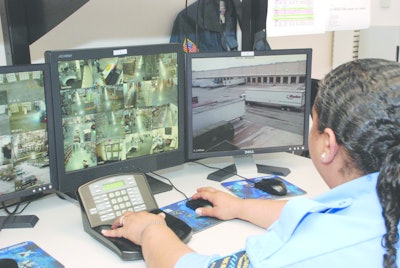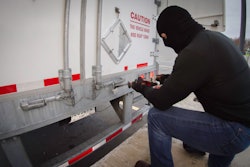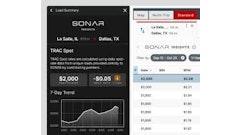
With the cost of food increasing, cargo theft can pose a serious threat to both the company and the economy. According to the FBI statistics, all forms of cargo theft could be as high as $30 billion in losses each year. Following these eight steps along with advice from the industry experts, can provide helpful information in order to ensure the safety of the drivers and cargo.
Internal Theft
1. Audit the Distribution Center
With ongoing efforts of loss prevention, frequently assessing your distribution center is vital to ensure that none of your cargo becomes missing. Internal theft has become one of the biggest problems for most companies in the food industry. By becoming aware of what takes place at the distribution center it will be easier to avert and identify any form of overloading that takes place.
“This is the easiest way that a food company can easily run into a six-figure loss from collusive theft,” says Barry Brandman, president of Danbee Investigations, Midland Park, NJ. “It’s not unusual that once an [employee] begins to steal that they continue and over time you’ll typically find that their theft activity will increase either in frequency or in volume.”
Your company will be more economically sound by making sure you have a solid inventory management system. By openly auditing your distribution center, employees will be less likely to steal. If an employee feels they’re at a high risk of getting caught, most employees will not attempt to steal the cargo.
Investigating shrinkage that may occur in your distribution center should be done in a timely fashion. Waiting too long to investigate your shrink can result in not finding the source of where the shrink occurred. By investigating your shrinkage on a daily basis, internal shrinkage may decrease due to the fear of employees getting caught.
By executing frequent distribution audits, you will be able to weed out of any dishonest employees who may have been involved in collusive theft.
2. Weed Out Dishonest Employees
Screening potential employees is essential in order to obstruct the possibility of internal theft from occurring. One way to accomplish this is to outwardly promote the use of anonymous tip lines. “Tip lines can be effective, but they have to be structured properly,” Danbee’s Brandman recommends.
Effective tip lines include providing complete anonymity. If an employee feels that his voice will be recognized by the person on the receiving end, this will cause him to remain silent in fear of retaliation from a dishonest employee; the inside information will go unheard and the internal theft will persist.
Although anonymous tip lines can be useful, they really shouldn’t be relied on as the primary method of shrinkage detection, says Bill Anderson, group director of security and international safety for Ryder System Inc., Miami. The most useful way to expose shrinkage would be to conduct frequent audits in the distribution center.
One definite way to ensure complete anonymity is to employ an external tip line. “Employees feel much more comfortable speaking with somebody from the other end of the phone that they never met and never will,” says Brandman.
Anonymous tip lines that provide complete anonymity are a great and easy way to prevent internal cargo theft. Along with tip lines, it is also important for a company to engage in external overt surveillances.
3. External Surveillances
Both overt and covert surveillances should be utilized in the warehouse distribution center as well as on company vehicles. These methods help to prevent and spot internal cargo theft. Using security systems such as CCTV on the loading dock, the gates and where the vehicles park is important to have and more importantly, should be checked daily in order to detect any suspicious activities. Alongside the security cameras, there are two methods of overt and covert surveillances: unannounced security audits and external non-covert surveillances.
Unannounced security audits occur when the auditor unloads the product off of the truck and confirms whether or not any extra products were added to the truck. Any extra merchandise will become apparent to the auditors and will be formally reported. By attaining the chain of custody, you will be able to find out the people that were responsible for putting the extra product onto the truck.
Finding out the people who were responsible for handling the products doesn’t necessarily mean they had the intent to steal, but rather portrays an unacceptable level of carelessness in handling the cargo. “The individuals may jeopardize their positions with the company – not for dishonesty, but for negligence,” says Brandman.
Similarly to unannounced security audits, external non-covert surveillances take place on the road, at each location where the driver delivers his goods. When the driver arrives at each stop, he is approached by a security auditor in order to verify the delivery. The auditor will be able to find any leftover cargo that remains in the truck, since the audits that occur throughout the course of the day will prevent the driver from delivering any overloaded products to his accomplices.
“Those two techniques – the internal security audits and the external non-covert surveillances – have proven year after year to be extremely successful for food companies,” says Danbee’s Brandman.
4. Forming An Alliance
By forming an alliance with other companies such as law enforcement organizations, this helps you to stay informed about the latest news and trends of cargo theft. “We partnered with Homeland Security to basically do what’s called a critical infrastructure briefing,” states Ryder’s Anderson.
Forming alliances with law enforcement organizations allows you to get valuable advice from the security experts. By forming an alliance it enhances communication and promotes safety awareness among the companies, which adds another layer of security.
Aside from internal theft problems, there are also many forms of external theft, which can be prevented with the proper care.
External Theft
5. Background Check for Fraud
In order to ensure that you’re dealing with legitimate carriers, it is crucial to make sure you conduct a background check: Portland, OR’s TransCore Freight Solutions provides that service. “We provide a network for transportation companies,” states Michele Greene, group product manager for TransCore Freight Solutions. TransCore’s network acts as a law enforcement company in order to make sure carriers are reputable and to also put a stop to fraudulent companies.
“It’s that first interaction with a new carrier where you are most at risk,” Greene says. “With modern day computing it’s not that difficult to doctor up a set of paperwork that to an untrained eye would make you look like a bona fide carrier.”
TransCore Freight Solutions provides historical information of the transportation companies that are in their system as a service to their customers. When checking to make sure your carrier is a legitimate company, you should conduct a background check on the information they provide you with such as: name, number, and address of the carrier. “The preventative aspect is as important as anything else,” says David Schrader, senior vice president of TransCore Freight Solutions. “Especially when you’re dealing with a party you have not dealt with before.”
6. Be Alert to Suspicious Activity
One common form of theft is when the drivers’ trailer truck is either broken into or stolen. “There’s organized crime and there’s opportunistic,” says Ryder’s Anderson. Organized crime usually watches the driver when he leaves the distribution center and follow him until his first rest break, says Anderson.
In order to help prevent a driver from being followed, it is recommended that he remain driving for at least 250 miles before resting. By doing so, this forces the offender to follow you for 250 miles. You should always report any suspicious activities that you see.
When a driver stops at a rest point, there are many ways to help ensure a safer stop.
7. Practice Safe Parking Habits
Parking, no matter where you are, puts your cargo at risk of theft, said Anderson.
Companies should limit where drivers are permitted to stop for breaks, since there are some locations that are more of a high risk for cargo theft than others. The companies should be aware of safer rest stops in order to assure the safety of the driver and the cargo.
Some ideal elements to look for when choosing a safer truck stop would be to be aware of places with good lighting and parking in close proximity. By parking close a driver is able to spot any suspicious activities that may occur while he’s away and report what he sees in a timely manner.
Remembering to lock the doors and remove the keys from the vehicle are good basic safety habits. Also when returning to your trailer, survey the vehicle and look for any signs of tampering. Using the right kind of equipment will delay a theft in progress.
8. Utilizing the Right Equipment
With so many different types of equipment on the market, it may be confusing when it comes to choosing the best gear for your trailer. A very basic must-have safety feature for your truck would be a round lock with a hidden shackled padlock. The sheltered shackle makes it virtually impossible to defeat the lock, consequently making it harder for cargo to be stolen. The round padlocks are industrial strength locks that, according to American Lock, can protect against: drilling, sawing, prying, crowbars, dent pullers and hammers.
Another beneficial basic security device created by Master Lock is called The Bump Stop. “We’ve seen over the years that there has been a threat of people bumping locks and we have a reverse taper pin that we utilize in the padlock that deters entries like that,” says John Ficcadenti, senior product manager of security products at Master Lock, Milwaukee. “Bumping is basically another form of picking a lock.”
Trailers are at a high risk when they are not attached to a truck. One way to prevent possible theft of the entire trailer is with the King Pin lock by attaching it to the stem of the trailer in order to prevent another truck from pulling away with the complete trailer.
Other forms of equipment are electronic technologies that can be used on the trailer. “The most common is vehicle-based GPS, which allows logistic companies to track vehicles and keep an eye on shipments,” states Ryder’s Anderson. Although vehicle-based GPS’s can track the location of the trailer, it has some disadvantages as well. “Many of the organized groups that commit these thefts are able to defeat the GPS system within seconds of absconding with the truck,” says Danbee’s Brandman. “They’ve been effective when it comes to amateur theft, but the professionals have no problem circumventing the technology out there.”
“One of the more recent developments is cargo-based GPS, which is a small device about the size of a cell phone that you can place inside the cargo,” says Anderson. Cargo-based GPSs uses duel receivers, which utilizes both cellular technology and GPS satellites. Like with other technologies, cargo-based GPSs do have drawbacks. They can be easily defeated with the use of cell phone jammers, which is used so the GPS is unable to receive a signal causing it to be disabled.
“If you create a layered security approach, it increases the amount of time it takes to steal that cargo. Detect, deter and delay are the three mantras to security,” concludes Anderson.




















